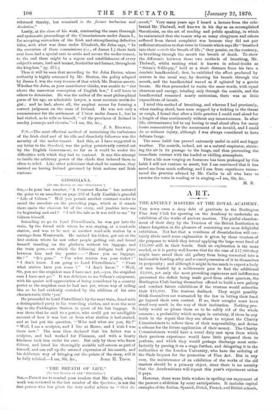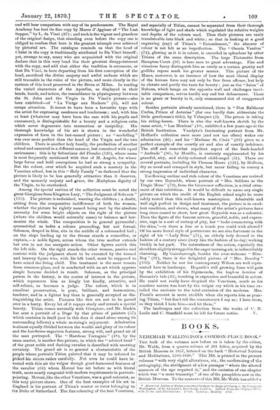ART.
THE ANCIENT MASTERS AT THE ROYAL ACADEMY.
THE town owes a deep debt of gratitude to the Burlington Fine Arts' Club for spurring on the Academy to undertake an exhibition of the works of ancient masters. The pitiful abandon- ment of their duty by the Trustees of the British Institution is almost forgotten in the pleasure of recovering our most delightful exhibition. Not but that a residuum of dissatisfaction will cer- tainly abide until some explanation is given by those trustees of the purposes to which they intend applying the large trust fund of £15,000 still in their hands. Such an explanation is the more needed, as it is pretty well known that for the sum of £17,000 they might have saved their old gallery from being converted into a fashionable bowling-alley and secured possession of it to themselves in perpetuity ; and although it might be too much to expect a body of men headed by a millionnaire peer to find the additional £2,000, yet only the most provoking supineness and indifference prevented time deficit being made good from other quarters, the Burlington Club having themselves offered to build a new gallery and conduct future exhibitions if the trustees would subscribe their £15,000. The trustees declined. They might possibly think themselves not warranted by the law in letting their fund go beyond their own control. If so, their scruples must have stood very much in the way of their inclination. Nothing pro- bably would so please them as to be safely rid of the whole concern ; a probability which merges in certainty, if there be any truth iu the report that they are about to request the Charity Commissioners to relieve them of their responsibility, and devise a scheme for the future application of their money. The Charity Commissioners would have a novel duty cast upon them which their previous experience would have little prepared them to perform, and which they would perhaps discharge most satis- factorily by passing it on a stage further, and delegating it to the authorities at the Loudon University, who have the ordering of the Slade bequest for the promotion of Fine Art. But in any case, the maintenance of an exhibition of the works of the old masters should be a primary object, since there is no security that the Academicians will repeat this year's experiment unless it pays.
However, there were little wisdom in spoiling our enjoyment of the present e xhibition by sorry anticipations. It includes capital examples of the Italian, Spanish, Dutch, French, and British schools,
and will bear comparison with any of its predecessors. The Royal Academy has lent its fine copy by Marco d'Jggione of "The Last
Supper," by L. da Vinci (87) ; and such is the vigour and grandeur of the original design, that standing even before the copy one is obliged to confess that here is the greatest triumph ever achieved by pictorial art. The catalogue reminds us that the head of Christ in the copy is traditionally attributed to Da Vinci himself ; yet, strange to say, many who are acquainted with the original declare that in this very head lies their greatest disappointment with the copy, and add that either the tradition is erroneous, or that Da Vinci, in here departing from his first conception of the head, sacrificed the divine majesty and awful sadness which are still traceable in the ruins of the picture, and more clearly in the cartoon of this head preserved in the Brera at Milan. In reading the varied characters of the Apostles, as displayed in their heads, hands, and action, the resemblance in physiognomy between the St. John and the Virgin in Da Vinci's picture—also here exhibited—of "La Vierge aux Rochers" (6), will not escape attention. It seems to have been a favourite type with the artist for expressing meekness and tenderness ; and, with him at least (whatever may have been the case with his pupils and successors), is distinguishable for a beauty and a religious calm which never degenerate into mannerism or insipidity. His thorough knowledge of his art is shown in the wonderful expression of form in the last-named picture ; no " modelling" was ever more perfect than the head of the Virgin and the two children. There is another holy family, the production of another school and executed in a different manner, but conceived with equal seriousness ; this is by Sebastiano del Piombo (130), whose name is most frequently mentioned with that of M. Angelo, for whose large forms and bold conceptions he had so strong a sympathy. But the colour, over which he acquired such a mastery in the Venetian school, has in this " Holy Family " so darkened that the picture is likely to be less generally attractive than it deserves, and the womanly majesty and grace, the iEschyleau dignity of the Virgin, to be overlooked.
Among the special rarities of the collection must be noted the great Giorgione from Kingston Lacy, "The Judgment of Solomon " (115). The picture is unfinished, wanting the children ; a doubt, arising from the comparative indifference of both the women, whether the picture be rightly named being met by the absolute necessity for some bright objects on the right of the picture (where the children would naturally come) to balance 4,nd har- monize the whole. The composition is in general pyramidal ; symmetrical as befits a solemn proceeding, but not formal. Solomon, draped in blue, sits in the middle of a colonnaded hall ; on the steps leading up to the throne stands a councillor, or captain,— a noble figure, across whom the true mother extends her arm in not too energetic action. Other figures enrich this the left side. On the right stands the other woman, passive and content with the judgment about to be executed by the tanned and brawny figure who, with his left hand, must be supposed to have seized the living child. The treatment is the most remote from common-place, and is conducted with an art which appears simple because decided in result. Solomon, as the principal person in the history, is the centre of interest in the picture, which represents him as kingly but kindly, attentive, and self-reliant, as becomes a judge. The colour, which is in excellent preservation, is pure, brilliant, and harmonious, tenderer, and in a lighter key than is generally accepted as dis- tinguishing the artist. Pictures like this are not to be passed over in a hurry. Every bit of it repays study and reveals a special beauty. Titian comes naturally with Giorgione, and Mr. Ruskin has sent a portrait of a Doge by that prince of painters (57) which contains in itself (nor in this does it stand alone among its surrounding fellows) a whole morning's enjoyment. Admiration is almost equally divided between the wealth and glory of its colour and the handsome sagacious features, strong will, and grand air of the man portrayed. The " Marchese Tarragnio " (48), by the same master, is another fine picture, in which the " advised head " of the great noble and dashing cavalier is described with unerring certainty. The grand air is so general a characteristic of the people whose portraits Titian painted that it may be inferred he
picked his sitters rather carefully. Not even he could have in- vested with this air the vulgar though good-humoured features of the cavalier (64) whom Moroni has set before us with literal truth, more nearly congenial with modern requirements in portrait- painting.
Moroni, like the other Venetians, was a good colourist, as this very picture shows. One of the best examples of his art in England is his portrait of Titian's master or tutor belonging to the Duke of Sutherland. The fine colouring of the best Venetians,
and especially of Titian, cannot be separated from their thorough knowledge of light and shade which regulated the relative weights and depths of the colours used. Thus their pictures are easily translateable into black and white ; so that in looking at a good engraving (say) of Titian's " Entombment," the absence of colour is not felt as an imperfection. The " Omnia Vanitas" (74), glowing as it is in colour, is exceeded in splendour by other Titians of the same description. The large Tiutoretto from Hampton Court (96) is here seen to great advantage. Fire and vivacious fancy distinguish him as surely as a certain gravity and godlike repose mark his greater master. This picture of the Muses, moreover, is an instance of how the most liberal display of the human form may not only be free from offence, but help to elevate and purify the taste for beauty ; just as the "Ixion" of Rubens, which hangs on the opposite wall and challenges inevi- table comparison, serves hardly any end but debasement. There is no grace or beauty in it, only unmeasured riot of exaggerated colour.
Besides portraits already mentioned, there is " Don Balthazar Carlos, Prince of Asturias" (for one hardly dare abbreviate the little gentleman's title), by Velasquez (2). The prince is taking his riding-lesson. There is also the well-known sketch by the same artist, " Las Meninas" (10), exhibited a few years ago at the British Institution. Vandyke's fascinating portrait from Mr. Holford's collection once more (and not too often) wakes our admiration (26) ; and his "Madame St. Croix" (83) gives us a perfect example of the courtly air and also of courtly indolence. The stiff and somewhat repellent aspect of the bush-headed " Andrade " (86), by Murillo, is curiously supplemented by his graceful, airy, and richly-coloured child-angel (51). There are several portraits, including Sir Thomas Moore (121), by Holbein, dry as usual and cramped in style, but never failing to convey a strong impression of individual character.
Tile flowing outline and rich colour of the Venetians are revived by our own Reynolds, whose portrait of " Mrs. Siddons as the Tragic Muse" (79), from the Grosvenor collection, is a chief orna- ment of this exhibition. It would be difficult to name any single picture on which the credit of the English school might be more safely rested than this well-known masterpiece. Admirable and well nigh perfect in desigu and treatment, the picture is in excel- lent condition, and shows, what many of the artist's pictures have long since ceased to show, how great Reynolds was as a colourist. Then the figure of the famous actress, graceful, noble, and expres- sive, rapt in a sort of ecstasy of pity, her " looks commercing with the skies,"—is there a line or a touch you could wish altered ? Of his more literal style of portraiture we are also fortunate in the sight of his " Lady Bute" (71), an elderly lady dressed in the fashion of a century since (very like the fashion of to-day) walking briskly in her park. The naturalness of the action, especially the shoulders slightly shrugged in the eager morning air, is indescribably charming. By Gainaborough, besides the ever-welcome " Blue- Boy " (91), there is the delightful picture of " Mrs. Beaufoy " (105). Neither he nor his contemporary Wilson are well repre- sented here in landscape. Hogarth's still growing fame will gain by the exhibition of his Sigismunda, the hapless heroine of Boccacio's tale (43), touching in expression and beautiful in colour. Ile could not really have despised the Venetians, much as his sensitive nature was hurt by the vulgar cry which in his time ex- tolled the ancients to the total exclusion of the moderns. Mrs. Piozzi's account is more credible when she reports him as prais- ing Titian, "but don't tell the connoisseurs I say so ; I hate them, so they think I bate him—and let them."
The landscapes and the collection from the works of C. R.
Leslie and C. Stanfield must be left for future notice. V.



































 Previous page
Previous page